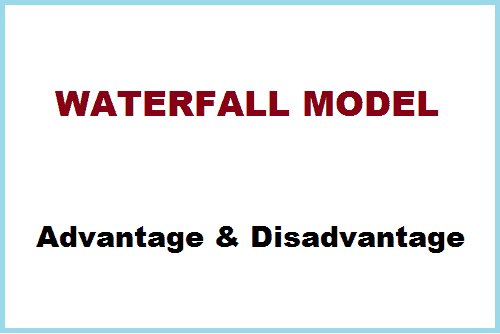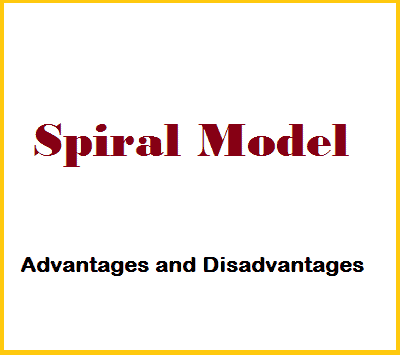The waterfall model is the earliest approach used in the process of software development in SDLC. It is used in the IT industry to ensure the success of the software product.
The process works in a linear sequential flow in which the phase of the process starts when the previous phase completes the process first. The waterfall model never overlaps. This article explains what is Waterfall model and its design, its applications, advantages and disadvantages in detail.
What are the Waterfall Model and its Design?
Waterfall model is a sequential model that divides the process into pre-defined phases. Each phase of the project will be processed after the completion of the previous phase. It never overlaps between the phases.
Each phase of the process is designed to perform the specific action in the project. The waterfall model is used in the earliest stage of SDLC approach. It illustrates in a linear flow. In this model the outcome of the current phase acts as the input of the next phases sequentially.
Sequential Phases in the Waterfall Model
The following illustration is the required sequential phases in waterfall model used in SDLC.
Requirement Gathering: The first phase of the model is gathering the entire possible requirement needed for the development process.
Analysis: Once the information is gathered, in the next step start analyzing the available information. Start to make documentation for the specific requirement used in the development process.
System Design: The required hardware and software requirements help in defining the system architecture. The system design is prepared accordingly.
Implementation: Once the information is gathered, requirements are analyzed and the system design is integrated then starts the implementation process for the fine-tuned output.
Unit Testing: From the input of the system design, make a small program called units. Each unit is developed for testing and functionality.
Integration and Testing: The multiple units developed in the implementation process are now integrated with the integration process after testing each unit. The post-integration is done to find any faults and failures.
Deployment of System: Deploy the application in the perspective environment. After the successful completion of functional and non-functional testing, deployment is performed.
Once the entire process is completed, the project is deployed in the client environment. There may be some installation issues or mismatching occurred at the time of deployment. It is essential to fix the issues in the client environment and ensure the successful implementation of the project as per the client requirement.
Maintenance stage: Enhance the product with better versions maintenance is done to deliver the changes in the client place. Maintenance of software is also done to make changes as per the client update. The waterfall model ensures no overlap of phase during execution.
Waterfall Model – Application
The waterfall model applications are developed based on internal and external focus. The waterfall model software is developed uniquely. It is best suited for the SDLC approach. The waterfall model is best suitable for the following conditions:
- When the projects are short and not have any complex applications to be resolved.
- It is best suitable for a small project.
- The requirement of data is clear and the environments are stable.
- When the resources are easily available and the requirements are not changing frequently.
- Technology and tools used are stable and not dynamic.
- Ample resources are available with the best support from expertise.
Advantages & Disadvantages of Waterfall model
The waterfall model follows a linear sequential flow from concept, analysis, system, design, implementation, testing and validation. Each phase is processed in strict order.
The notable advantages & disadvantages of the Waterfall Model are as follows:
Waterfall model – Advantages
Easy to understand: The waterfall model is easy to understand and simple to use. The first phase of the output acts as the input of the second phase and helps the developer to work on the project and never feels bored.
Simple to Manage: The phases can be reviewed with ease of access. Hence the process is easy to manage. The project can be delivered in a specified requirement due to the rigidity of the model.
Time: It takes less time for validations as the phases are processed and tested in a single time.
Small projects: It is best suited for small projects where the requirements are defined clearly. In small projects, the requirements are explained clearly in each stage and it is easy to understand the process in small requirements.
Validation: The waterfall model is identically performed with the continuous phase. Hence the testing, verification, and validation are assured before completing each stage.
Tasking: In small projects, it’s easy to arrange tasks in a sequential way. The waterfall model works in a sequential linear phase. So the tasking is easy in this SDLC model.
Changes: It is easy to make changes in the project during development. But it requires a stable environment to perform the task without errors.
Documentation: The process is well suited for clear defined stages. The process, validation, and results are well documented. Elaborate documentation is done at each phase of SDLC.
Waterfall Model – Disadvantages
The major disadvantage of the waterfall model is once the application is processed in the testing stage, it is difficult to go back to the phases to make changes.
- As it works in a linear sequence, the change in one phase will affect the before phases as their output of successive phases act as the input to the predicates.
- It is difficult to make documentation if any changes occurred in the middle phase. In that case, the entire document must be reprocessed.
- The project does not allow any reflection or revision in the entire phase.
- The project involves a high amount of risk, uncertainty, and late during the changes and collaboration of the life cycle.
- It is not suitable for long term projects, complex projects, poor model ongoing projects, and object-oriented projects.
- The waterfall model is never suited for high and moderate risk changing of projects.
- The testing of the process quite comes late as the error fixing takes time.
- Client feedback is not included in the ongoing development phase. It is the major drawback of the project.



